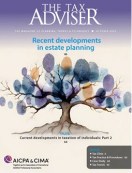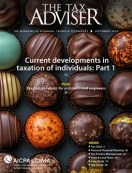- newsletter
- TAX INSIDER

3 common misconceptions about defined benefit plans
Defined benefit plans permit larger employer contributions than most qualified retirement plans and are worth a look despite these misconceptions.
Please note: This item is from our archives and was published in 2020. It is provided for historical reference. The content may be out of date and links may no longer function.
Related
Inflation adjustments to retirement account limits issued for 2026
Premium or paycheck? Tax treatment of secondary sales above FMV
Planning with charitable remainder trusts
Defined benefit plans allow small business owners to set aside more money for retirement than other traditional retirement plans. A defined benefit plan is a qualified retirement plan that defines a specific benefit when a person retires; funds can be invested at the trustee’s discretion. However, unlike in a typical 401(k) plan, the trustee bears the risk of the investments as well as the full range of fiduciary obligations under ERISA.
Annual contribution levels are based primarily on actuarial calculations, plan design, and existing funding levels. There are some choices in setting up a plan, and the plan sponsor should understand the advantages and disadvantages of different plan design choices.
For CPAs, business is more competitive than ever. By offering small business clients the opportunity to set up defined benefit plans, practitioners can increase their value to their clients, as well as help clients succeed and save on tax. In a competitive world, tax advisers are always looking to differentiate themselves.
Let’s unpack the common misconceptions about defined benefit plans.
Misconception No. 1: Plans are too tough on cash flow
Defined benefit plans are administratively costly to the plan sponsor, although the plan sponsor may view this investment of expense and effort as worthwhile to offer it as an employee benefit. The administrative expense, which is typically greater than for a 401(k) plan, is due to the complexity of maintaining defined benefit plans. However, in years of higher cash flow, the plan sponsor may also see a tax benefit that would be greater than under a 401(k) plan.
A defined benefit plan provides substantial tax savings to a business owner, more so than many other forms of employer-sponsored retirement plans because they typically have higher contribution limits than other types of qualified plans.
Of course, many employers prefer to offer only a 401(k) plan due to the high risk and high expense of a defined benefit plan. If your clients are a fit, however, a defined benefit plan could be an option.
These plans can often put an owner in a lower tax bracket and unquestionably allow the owner or partners of a business to keep more of their profits.
A defined benefit plan may make sense for a company whose owner can contribute at least more substantial amounts over a one-year time frame. If the business owner cannot contribute a substantial amount consistently, a standard 401(k) account may be a better choice.
Therefore, defined benefit plans should be examined when business owners want to offer a retirement plan for their employees and may be in a position to enjoy incidental tax benefits as a result. These plans can be standalone or complement existing employer plans.
Misconception No. 2: Plans aren’t flexible
Defined benefit plans are more flexible than some tax advisers may think.
A business owner should not establish a plan unless he or she intends to fund it annually. Although plans can be amended from time to time to effect a change in contribution levels, under IRS rules the plan is for the exclusive benefit of the participants and their beneficiaries and should be maintained accordingly.
Plan contribution levels are adjusted each year and may be amended (for additional fees), if the desired contribution level needs to be revised.
Business owners should work closely with advisers and actuaries to understand what their contribution obligations will be and how that may change because of different plan designs and actuarial assumptions.
Misconception No. 3: Every employee must be covered
As with a 401(k) plan, assuming a plan can pass “discrimination testing,” not every employee needs to be covered. Key and highly compensated employees can often be excluded.
Now that the common misconceptions are out of the way, let’s look at a summary of the advantages of a defined benefit plan.
Defined benefit plan benefits
The benefits of establishing and maintaining a defined benefit plan are substantial, with the following attributes being useful for clients:
- Certain types of defined benefit plan distributions are eligible for roll over to other tax qualified plans;
- The plan has certain advantages for owners and partners, not found in a 401(k) plan;
- Employee benefit plan contributions are immediately tax-deductible by the employer; and
- Assets of qualified retirement plans are generally protected from creditors.
Benefits of timing advantages
Creating a defined benefit plan has many timing advantages that business owners should be aware of:
- The plan will not necessarily need to be funded upon creation; and
- The plan can be funded according to plan design and conforming to IRS and ERISA requirements but must be funded annually.
An example of the timing advantages would be an owner’s creating a plan on a specific date but only having to fund it according to an agreed-upon timeline based on the plan design:
- Once upfront;
- Monthly payments; or
- The total amount being funded one year after the plan has been taken out.
To set up a tailored defined benefit plan that is best suited to your clients’ needs, find a specialist who has experience working with many different actuarial designs.
— David Podell has been advising business owner clients for the last 17 years. He has been recognized in the industry as a top producer and focuses his business practice in advising business owners. He works with clients around the country and can be reached at 973-227-8001 or dpodell@podellfinancialgroup.com.. To comment on this article or to suggest an idea for another article, contact Sally Schreiber, a Tax Adviser senior editor, at Sally.Schreiber@aicpa-cima.com.
David Podell is a Financial Advisor offering investment advisory services through Eagle Strategies LLC, a Registered Investment Advisor & a Registered Representative offering securities products and services through NYLIFE Securities LLC, (member FINRA/SIPC), a Licensed Insurance Agency. Neither Podell Financial Group, LLC, its employees nor NYLIFE Securities LLC or its subsidiaries provide tax, legal or accounting advice. You should consult your own professional counsel before taking any related planning action. Podell Financial Group is independently owned and operated from Eagle Strategies LLC and its affiliates.
These plans don’t work for everyone and the information described in this article does not uniformly apply to every business. Each plan is unique in design and structure. It is important to analyze your client’s tax bracket now and in the future to determine if this plan would be a good fit. The author is not offering tax, legal, or accounting advice.














